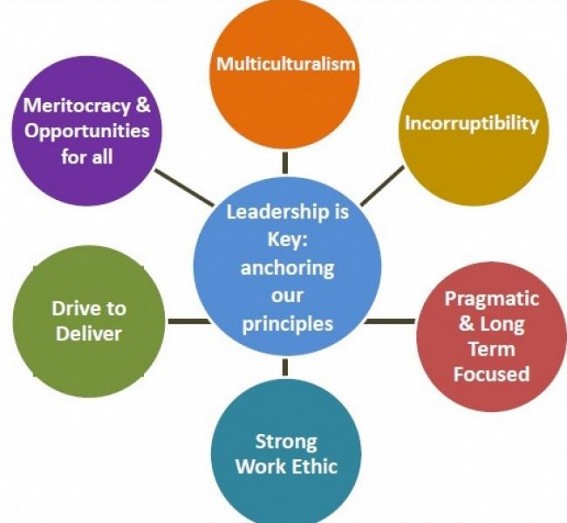Abhishek Singh

PHOTO : Picture source : Abhishek Singh, IAS, CEO, TTAADC
Not many nations could graduate from third world to first world in a generation time. Most of the countries under erstwhile colonial rule which got independence in the mid 20th century are still entwined in the vicious cycles of poverty, unemployment, population explosion, corruption & low HDIs. Singapore has been one such example to have the turnaround within a generation. Today it is not only a developed nation but has been leading the developed countries in governance, urban redevelopment, water management, corruption control, civil services reforms & a leading business center.
During the Mid 1950s when British Colonies in Asia & Africa were getting Independence, Singapore was among the last such precious possession surrendered by British but only to neighboring country Malaysia. This was an island with no natural resources inhabited by immigrant Chinese, Malays & Indians brought by British to work for its interests to develop it as a port of call & strategic location. But after the surrender of British Army to Japanese invasion of Singapore during world war-II, the natives realized its vulnerability & their limited future under Colonial rule.
Though Singapore did get its self rule as a dominion state in 1959 but it had to be dependent on Malaysia for almost everything from food to finance. But soon, Malaysians found it to be a burden on their resources & a threat to the ethnic majority of Malays. And Singapore was thrown out of Malaysia to get its undesired Independence in 1965. At this time it had all the worries of a poor & resource less third world country sitting on a population of 1.5 million with multi racial/ ethnic society. Corruption was at its peak & public institutions which were hitherto accustomed to subserve to colonial interests failed to live up to the challenge of people centric development. With 19% unemployment, lack of civic infrastructures & facilities, traditional unproductive agrarian practices,frequent riots the very philosophy of a nation was under threat & crumbling for the ills of British raj & immaturity of the Democracy. Threat of a Communist China take over or becoming a puppet of America or expendable buffer of Malaysia was very real.
At this time the visionary leader Mr. Lee Kuan Yew became Singapore’s 1st Prime Minister & could foresee the challenge the nation had. He set out his vision to make Singapore essentially an urban business center with open & integrated economy with world, excellent public infrastructures, amenities & human resources. He traveled extensively & didn’t shy away from learning & bringing best practices from world that suits this city state. The regime continuity gave the nation necessary leverage to pursue its long term developmental goals earnestly. To bring more transparency, eliminating corruption in government & imbibing better civic behavior among people few harsh & non-populist measures were also taken which was also whole heartedly supported by the citizens. Rule of law & public order was given highest priority with no exceptions including the public leaders, Ministers & officials. The government played a key role in deciding the course of Nation’s progress with various legal, administrative & fiscal tools & never let it to be a rudderless ship. Pro-active policy with continuous adoption with the changing global & local scenario ensured the country was always prepared to embrace new intervention be it globalization, technology, competitiveness or market demands elsewhere.
A strong fiscal policy with constitutionally mandated surplus budget since last three decades provided required financial resources for taking ambitious projects like reclamation of lands, establishment of one of the largest & most advanced Airport on reclaimed land, Marina barrage, establishing world’s largest refinery on a reclaimed land, water purification & reuse and public housing etc to name a few. Development of human resources with making income opportunities available ensured lowest unemployment rate of 1-1.5%, which is mainly due to seasonal & transitional unemployment. Today Singapore is rated amongst top countries in most of the global indices. It has planned for its requirement & to cope up with any situation till 2030.
There are many things which India & other developing countries can learn from Singapore’s journey & would require a great deal of space to cover. However, considering the scope & immediate challenges, I shall be focusing on following issues i.e., Governance & public services, Urban development, Water management, Housing, corruption control & multi-ethnicity in this article.
Article continued in its original form of 12 pages in PDF form at this link below : Pl read /download
http://www.tripurainfoway.com/pdf/Singapore%20journey%20to%20glory%20by%20A%20Singh.pdf
Mr Abhishek Singh is MT cadre IAS officer serving in Tripura. He is currently CEO (Chief Executive Officer) of TTAADC
- Why Modi’s BJP swept key India regional elections
- TIWN’s landmark legal victory against BJP Govt’s Illegal attacks to shutdown fearless Media
- India to be world's third-largest economy by 2030 -S&P Global Ratings
- Tripura's Dark Era : Mafia style Brutal attacks on Journalists, fight for your Citizen rights !
- How to access tripurainfoway.com via HOLA from India



